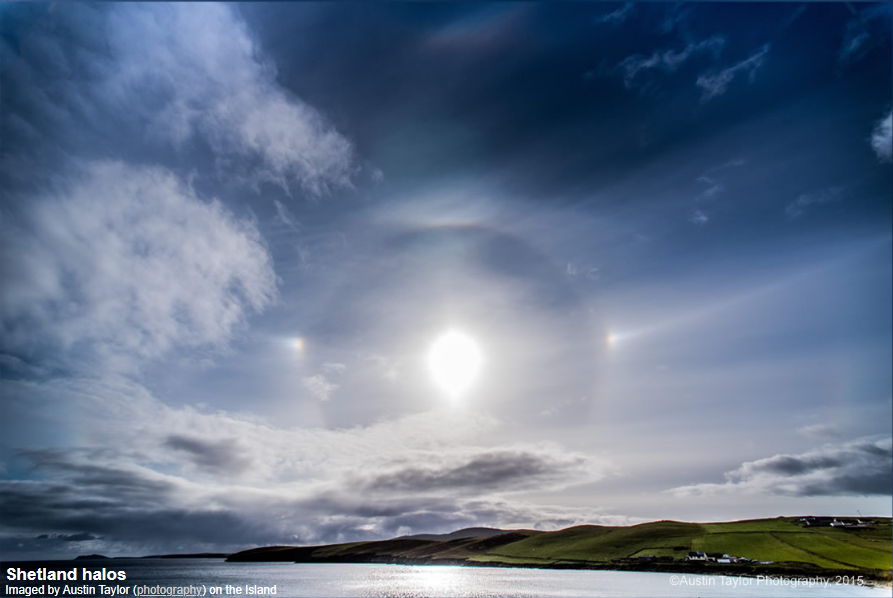Shetland Halos - OPOD
Shetland Halos: A Spectacular Atmospheric Phenomenon
Have you ever witnessed the enchanting display of Shetland halos? These captivating optical phenomena can be observed on the Island of Shetland, Scotland, and they never fail to leave spectators in awe. In this article, we will explore the intricacies of Shetland halos, shedding light on their various components and the scientific explanations behind them.
The 22° Halo and Sundogs
One of the prominent features of Shetland halos is the hazy 22° halo that encircles the sun. This halo is caused by the refraction and reflection of sunlight by ice crystals suspended in the atmosphere. However, what makes Shetland halos truly extraordinary is the presence of sundogs (22° parhelia) flanking the sun. These sundogs are located further than 22° away from the sun at certain solar altitudes, creating a mesmerizing visual spectacle.
The Parhelic Circle and Tangent Arcs
In addition to the 22° halo and sundogs, Shetland halos also exhibit other fascinating atmospheric phenomena. Above the sun, you may notice an upper tangent arc followed by an indistinct Parry arc. These arcs add a touch of mystique to the overall display. At the top of the image, you might catch a glimpse of a circumzenithal arc. Although faint and broad at this particular solar altitude, it adds an ethereal beauty to the scene.
Infralateral Arcs and Lowitz Arcs
As your eyes explore the Shetland halos, you may observe yet more captivating features. At the far left and right sides, colored infralateral arcs shine, further enhancing the celestial spectacle. However, what truly fascinates observers is the faint arc outside the 22° halo, passing through the right-hand sundog. This arc reveals an intriguing phenomenon known as Lowitz arcs. These arcs are often subtle and require a keen eye to detect, but they provide valuable clues to the intricate nature of Shetland halos.
Enhanced Images and Simulations
To gain a deeper understanding of Shetland halos and their components, researchers employ various techniques to enhance the images and simulate the phenomena. By slightly enhancing the images, researchers have discovered hints of middle Lowitz arcs and possibly lower Lowitz arcs. Color subtraction techniques have been used to bring out the middle Lowitz arcs, revealing their true splendor. Additionally, conventional levels adjustment followed by violent unsharp masking has proven to be effective in highlighting the Lowitz arcs.
The Position of Lowitz Arcs
A HaloSim ray tracing simulation has provided valuable insights into the positions of the Lowitz arcs within the Shetland halos. This simulation helps researchers visualize and understand the intricate interplay of light and ice crystals in creating these atmospheric phenomena. Interestingly, the "weakening" of the 22° halo near the sundogs is not a true weakening but rather a result of the overlap between the upper and lower Lowitz arcs, which strengthen the 22° halo at specific positions.
Unveiling the Mysteries of Shetland Halos
Shetland halos are truly a sight to behold, captivating observers with their intricate patterns and ethereal beauty. Although these phenomena have been studied and documented, there is still much to learn about their underlying mechanisms. Researchers continue to explore and analyze these atmospheric optics phenomena, uncovering new insights into the behavior of light in our atmosphere.
In conclusion, witnessing the phenomenon of Shetland halos is a breathtaking experience that showcases the wonders of our natural world. The interplay between sunlight and ice crystals creates a mesmerizing display that never fails to inspire awe. So, if you find yourself on the Island of Shetland, keep your eyes peeled for these remarkable atmospheric optics phenomena.

Shetland halos
Imaged by Austin Taylor (photography) on the Island of Shetland, Scotland. ©Austin Taylor, shown with permission
A hazy 22° halo circles the sun. Sundogs (22° parhelia) flank the sun but are further than 22° away at this solar altitude. A bright parhelic circle passes through them
Above the sun is an upper tangent arc and then an indistinct Parry arc. At top of the image is a a circumzenithal arc. Faint and broad at this solar altitude.
At far left and right coloured infralateral arcs shine.
There is more. Look at the faint arc outside the 22° halo and passing through the right hand sundog. Notice that the 22° halo is fainter close to the sundogs. Lowitz arcs! Always look for these clues.


Enhancements and a simulation confirm the Lowitz arcs.
The slightly enhanced image (A) hints at a middle Lowitz and perhaps a lower Lowitz.
The colour subtraction (B) brings out the middle Lowitz.
But conventional levels adjustment (C) followed by violent unsharp masking perhaps reveals them best.
At far right a HaloSim ray tracing shows the arcs' positions.
The 'weakening' of the 22° halo near the sundogs is relative. The 22° halo position at 2 and 4 o'clock is strengthened by overlap of the upper and lower Lowitz arcs.
Note: this article has been automatically converted from the old site and may not appear as intended. You can find the original article here.
Reference Atmospheric Optics
If you use any of the definitions, information, or data presented on Atmospheric Optics, please copy the link or reference below to properly credit us as the reference source. Thank you!
-
<a href="https://atoptics.co.uk/blog/shetland-halos-opod/">Shetland Halos - OPOD</a>
-
"Shetland Halos - OPOD". Atmospheric Optics. Accessed on November 26, 2024. https://atoptics.co.uk/blog/shetland-halos-opod/.
-
"Shetland Halos - OPOD". Atmospheric Optics, https://atoptics.co.uk/blog/shetland-halos-opod/. Accessed 26 November, 2024
-
Shetland Halos - OPOD. Atmospheric Optics. Retrieved from https://atoptics.co.uk/blog/shetland-halos-opod/.